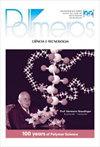Modification of poly(lactic acid) filament with expandable graphite for additive manufacturing using fused filament fabrication (FFF): effect on thermal and mechanical properties
IF 1.4
4区 化学
Q4 POLYMER SCIENCE
引用次数: 2
Abstract
Fused Filament Fabrication, better known as Fused Deposition Modeling®, is currently the most widespread 3D Printing Technology. There has been a significant demand for developing flame-retardant filaments. Thereby enabling them, for example, in electronics and automotive applications. In this study, commercial PLA filament was modified by the addition of 1, 3 and 5% (%wt.) of expandable graphite. The composites were reprocessed, via extrusion, into filaments for Fused Filament Fabrication. Thermal properties of the filament composites were evaluated by thermogravimetric analysis and differential scanning calorimetry. Mechanical properties of thermo-pressed specimens indicated that no strong adhesion was promoted between the filler and matrix. This is a challenge with expandable graphite reported by many authors. All composites with expandable graphite achieved the V-2 rating of UL-94 flammability test. In spite of this, the results indicated that flammability of the PLA was reduced. All composite filaments were printable and prototypes were successfully 3D printed.熔融增材制造用可膨胀石墨改性聚乳酸长丝:对热性能和力学性能的影响
熔融长丝制造,更好地称为熔融沉积建模®,是目前最广泛的3D打印技术。开发阻燃长丝的需求很大。从而使它们,例如,在电子和汽车应用。在本研究中,通过添加1,3 %和5% (%wt.)的可膨胀石墨对商用PLA长丝进行改性。复合材料再加工,通过挤压,成为长丝的熔融长丝制造。采用热重分析和差示扫描量热法对复合材料的热性能进行了评价。热压试样的力学性能表明,填料与基体之间没有很强的粘结性。这是许多作者报道的可膨胀石墨面临的挑战。所有膨胀石墨复合材料均达到UL-94可燃性试验的V-2级。尽管如此,结果表明PLA的可燃性降低了。所有的复合材料长丝都是可打印的,原型也成功地3D打印出来。
本文章由计算机程序翻译,如有差异,请以英文原文为准。
求助全文
约1分钟内获得全文
求助全文
来源期刊

Polimeros-ciencia E Tecnologia
化学-高分子科学
CiteScore
2.00
自引率
0.00%
发文量
14
审稿时长
6 months
期刊介绍:
Polímeros is a quarterly publication of the Associação Brasileira de Polímeros - ABPol (Brazilian Polymer Association), which publishes Review Articles, Original Articles and Short Communications, disclosing advances in the knowledge of Polymer Science and Technology.
 求助内容:
求助内容: 应助结果提醒方式:
应助结果提醒方式:


